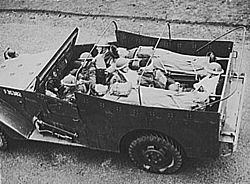| M3A1 scout car | |
|---|---|
 M3A1 scout car in British Army service, 1942 | |
| Type | Armored car |
| Place of origin | United States |
| Service history | |
| Used by | See Operators |
| Wars | World War II Second Sino-Japanese War Chinese Civil War Hukbalahap Rebellion Indonesian National Revolution Greek Civil War 1948 Arab–Israeli War Costa Rican Civil War 1958 Lebanon crisis First Indochina War Algerian War Laotian Civil War Cambodian Civil War Congo Crisis Dominican Civil War Portuguese Colonial War Salvadoran Civil War |
| Production history | |
| Designer | White Motor Company |
| Designed | 1939 |
| Manufacturer | White Motor Company |
| Produced | 1939–1944 |
| No. built | 21,054 (M1: 76 + M2: 20 + M2A1/M3: 64 + M3A1: 20,918) |
| Specifications | |
| Mass | 6.25 short tons (5.67 t) |
| Length | 18 ft 5 in (5.61 m) |
| Width | 6 ft 8 in (2.03 m) |
| Height | 6 ft 5 in (1.96 m) |
| Crew | 8 |
| Armor | Maximum .5 in (13 mm) |
Main armament | .50 cal M2 Browning |
Secondary armament | 1–2 x .30 cal M1917 Browning or M1919 Browning machine guns |
| Engine | Hercules JXD 6-cylinder in-line petrol 110 hp (82 kW) |
| Drive | Wheeled 4x4 |
| Suspension | Leaf springs |
| Fuel capacity | 30 US gal (110 L) |
Operational range | 250 mi (400 km) |
| Maximum speed | 50 mph (80 km/h) |
| References | Bishop [1] & Foss [2] |
The M3 scout car (known as the White scout car in British Commonwealth service) was an American armored car produced in the World War II era, from 1939 to 1944. The original M3 scout car was produced in limited numbers, while the improved M3A1 scout car saw wide service during World War II and after.










